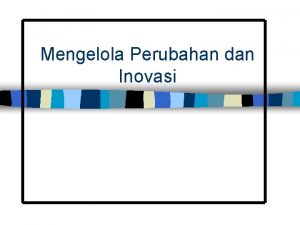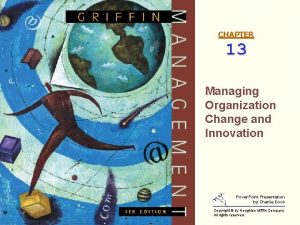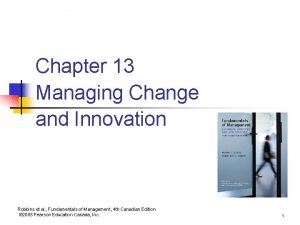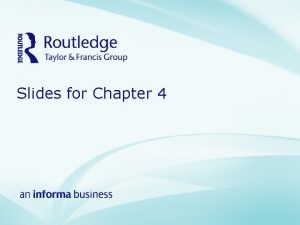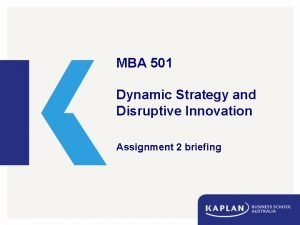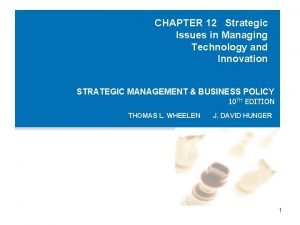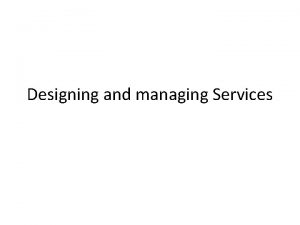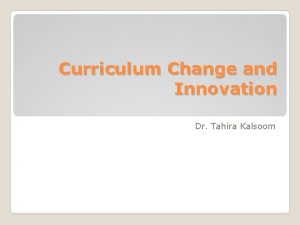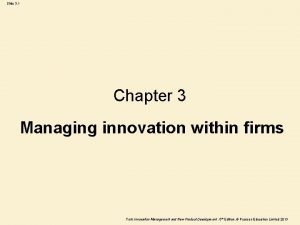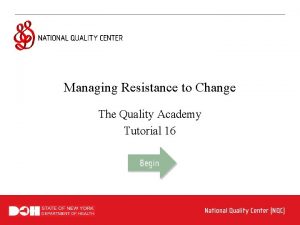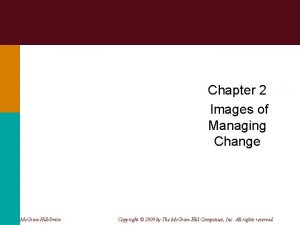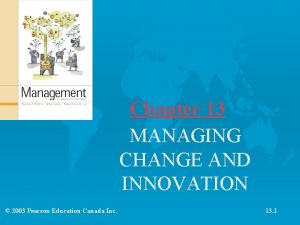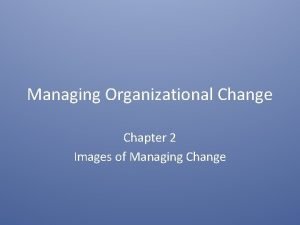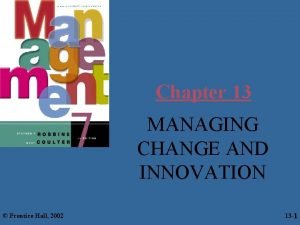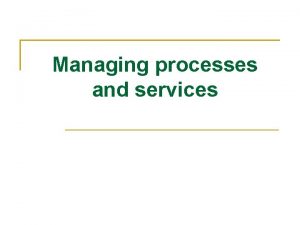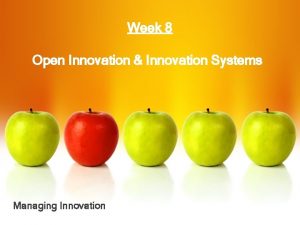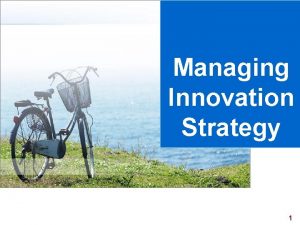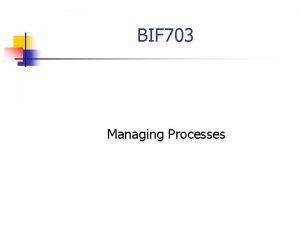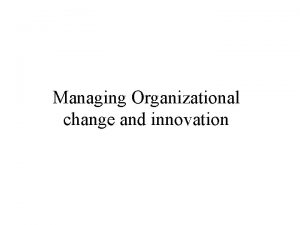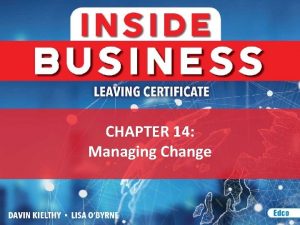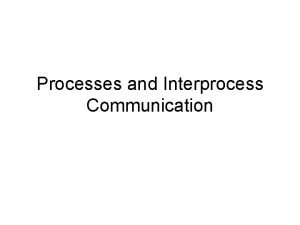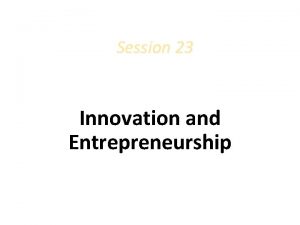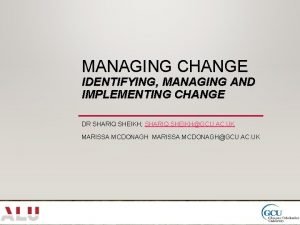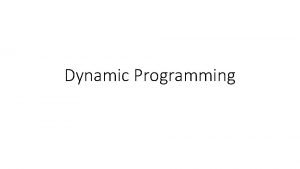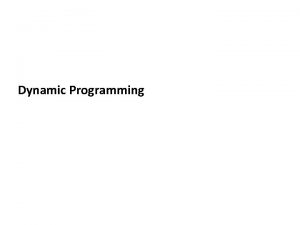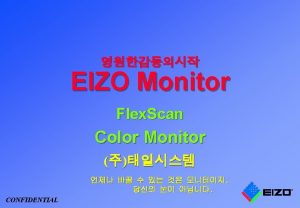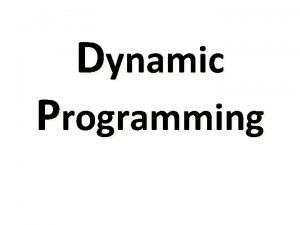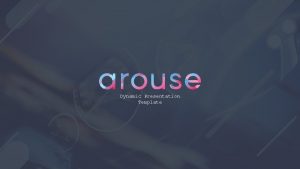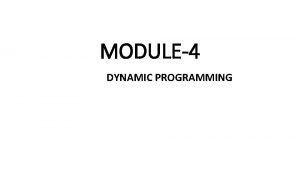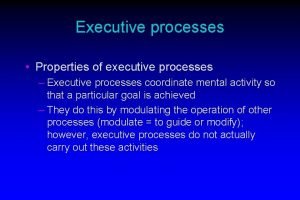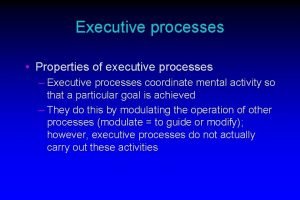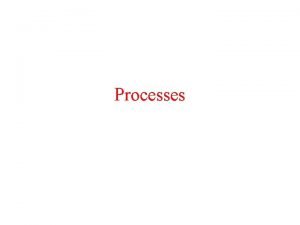Managing Innovation and Change Managing Dynamic Processes 5



























- Slides: 27

Managing Innovation and Change Managing Dynamic Processes (5) Dr. Tyge Payne Office: BA 1015 Office Phone: (806) 742 -1514 Email: tyge. payne@ttu. edu

Key Issues / Concerns u Technology & Task Design – Innovation Type – Sequential vs. Pooled vs. Reciprocal – Service vs. Manufacturing u Size – Size & Structure Relationship u Culture u Coordination and Control Systems u Power & Decision Making Ø Consider Fit / Misfit of ALL of these Factors T. Payne 2

Technology u Definition: (1) “the work performed by an organization, ” and (2) “the knowledge, tools, machines, information, skills, and materials used to complete tasks within organizations, as well as the nature of the outputs of the organization. ” u Technology’s link to the environment is paramount. – The environment is not only the source of inputs and the recipient of outputs, but also the major source of technical knowledge, work techniques, and tools employed by the organization. T. Payne 3

Incremental vs. Radical Change Incremental Change Radical Change Continuous progression Paradigm-breaking burst Affect organizational part Transform entire organization Through normal structure and management processes Create new structure and management Technology improvements Breakthrough technology Product improvement New products, new markets T. Payne 4

Tech Dimensions u Complexity or Diversity – The number of different items or elements that must be dealt with simultaneously. Specific measures include: t t The variety of inputs, and Multiplicity and customization of outputs. u Uncertainty or Unpredictability – The variability of the items or elements upon which work is performed or to the extent to which it is possible to predict their behavior in advance. Specific measures of uncertainty include: t t t Uniformity or variability of inputs, The number of exceptions encountered in the work process, and The number of major product changes. u Interdependence – The extent to which the items of elements up on which work is performed or the work processes themselves are interrelated so that changes in the state of one element affect the state of the others. There is pooled, sequential and reciprocal interdependence. T. Payne 5

Technology Interdependence u Paint Selection Pooled – the work performed is interrelated only in that each element or process contributes to the overall goal. u Sequential – when some activities must be performed before others. u Reciprocal – when elements relate as both inputs and outputs. Engine Assembly Engine Design Parts Manuf. Engine Design Wing Design T. Payne Aircraft Production Engine Assembly Aircraft Design 6

Task Design Types Form of Interdependence Demands on Horizontal Communications, Decision Making Pooled (financial planning) Low communication Client Sequential (assembly line) Type of Coordination Required Priority for Locating Units Close Together Standardization, rules, procedures Divisional Structure Low Plans, schedules, feedback Client Medium communication Task Forces Medium High communication Mutual adjustment, crossdepartmental meetings, teamwork High Reciprocal (hospital) Horizontal Structure Client T. Payne 7

Task Design Example Baseball Football Basketball Interdependence: (pooled, sequential, reciprocal) Physical dispersion (diversity) of players: (high, medium, low) Coordination: (what forces the play? ) Key management job: (coaches job? ) T. Payne 8

Service / Manufacturing 1. 2. Manufacturing Technology Tangible product Products can be inventoried for later consumption Capital asset intensive Little direct customer interaction Human element may be less important Quality is directly measured Longer response time is acceptable Site of facility is moderately important 3. Service Technology 4. 1. Intangible product 2. Production and consumption 5. take place simultaneously 3. Labor and knowledge 6. intensive 7. 4. Customer interaction generally high 8. 5. Human element very important 6. Quality is perceived and difficult to measure Product and Service: 7. Rapid response time is Airlines, Hotels, Consultants, Fast-food outlets, Cosmetics, usually necessary Law is firms 8. Healthcare, Site of facility extremely Real estate, Stockbrokers, Retail stores important T. Payne Product: Soft drink companies, Steel companies, Auto manufacturers, Food processing plants 9

Size u Size: Various ways to define, but depends largely on what is the purpose of the definition. – – – u Sales Profits Asset Value Number of Employees (most commonly employed) Market Share Concentration Ratios Size is also typically important when discussed relative to other firms in an industry; the industry itself has an impact (for instance non-profit organizations). T. Payne 10

Organizational Life Cycle Large Development of teamwork Addition of internal systems S I Z E Crisis: Need for revitalization Provision of clear direction Creativity Crisis: Need for delegation with control Crisis: Need for leadership 1. Small Entrepreneurial Stage 2. Collectivity Stage Streamlining, small-company thinking Continued maturity Decline Crisis: Need to deal with too much red tape 3. Formalization Stage 4. Elaboration Stage ORGANIZATION STAGES OF DEVELOPMENT T. Payne 11

Size & Structure Complexity Bureaucracy SIZE Scale of Operations Formalization Centralization T. Payne 12

Size: Positives & Negatives u Positives: – Better competitive position in the industry. – Gain better power over suppliers, buyers, regulators, and other environmental components. – Economies of Scale u Negatives: – Diminishing returns from economies. – Learning and communication restrictions. – Limited flexibility and change capabilities. T. Payne 13

Organizational Culture u Organizational Culture – (1) A set of broad, tacitly understood rules that tell members what to do under a wide variety of circumstances, (2) It is the patterns or configurations of interpretations—the shared meanings, beliefs, and assumptions giving consistency and predictability within the organization. u Two parts to culture: – Unobservable Components: Shared values, norms, and beliefs. – Observable Traces or Symbols: t Architecture t Myths t Artwork t Behavior t Dress t Rules t Language t Rituals t Stories t Ceremonies t Appearance T. Payne 14

Physical Manifestations of Culture u Rites, Rituals and Ceremonies – Public social events that mark the passage of some event or milestone. – Examples: orientation days, graduation ceremonies, department or company parties, retirement parties u Symbols and Slogans – HP: “invent” ; Wal-Mart: “Always low prices, always” ; UPS: “brown” ; Mickey Mouse ears; Nike swoosh; etc. u Language – Jargon or common languages that serve as shorthand to members is based on personal characteristics and devotion to a particular power holder. u Myths and Stories – History of operations or events that revolve around elements of truth, but are often distorted or exaggerated. u Physical Environment – Buildings, factories and grounds that develop meaning to the culture. – (1) Physical Structure; (2) Physical Stimuli; (3) Symbolic Artifacts T. Payne 15

Effects on Organizations u u u Direction – culture affects goal attainment (gives identity & purpose) Strength – the impact of culture on members individual actions Pervasiveness – the degree to which members share culture; pervasiveness is key to a “thick” culture (e. g. , widespread and accepted). u Flexibility – adaptability to changing conditions, established by: – Setting up a “devil’s advocate” to question actions of the organization. – Recruiting an outsider to bring in fresh ideas, although this may weaken morale. – Cross-training and job reassignments to reduce divisional alliances and encourage intra-organizational relationships. u Commitment – members of a group give their efforts, abilities, and loyalties to the organization and its pursuit of its goals in return for satisfaction. Proper missions and values promote this “emotional” investment in the organization. T. Payne 16

Negative Effects of Going Against Culture u Culture can strongly affect the ability of an organization to change directions. u Changes that do not align properly to the established culture, or that seek to alter it can have negative repercussions: – – Sabotage Foot-dragging Shirking Negative Conflict T. Payne 17

Controlling Organizations u Major Questions: – How do owners create control systems that maximize the effectiveness and efficiency of the organization? – How do owners make certain that employees do not loaf, steal, or engage in other counterproductive behaviors? – How do you ensure high quality output? u Organizational t t Economics Inform these Questions: Transaction Cost Economics – views the organization as a series of transactions. Agency Theory – regards the organization as a series of contractual relationships between owners and workers. T. Payne 18

Cultural Control Types TYPE REQUIREMENTS Bureaucratic (Machine) Rules, standards, hierarchy, legitimate authority Market Prices, competition, exchange relationship Clan Tradition, shared values and beliefs, trust

Management Control Systems u “If you can’t measure it, – Meg Whitman, CEO of e. Bay. Subsystem you can’t control it. ” Content Frequency Budget, Financial Reports Resource Expenditures, Profit and Loss Monthly Statistical Reports Nonfinancial Outputs Weekly or Monthly Reward Systems Evaluation of Managers and Employees based on Goals / Performance Yearly Quality Control Systems Participation, Benchmarking Guidelines Continuous T. Payne 20

The Balanced Scorecard FINANCIAL Objectives Measures Targets CUSTOMER “To achieve our vision, how should we appear to our customers? ” Objectives Measures Initiatives Hard Lagging “To succeed financially, how should we appear to our shareholders? ” INTERNAL BUSINESS PROCESSES Targets Initiatives Vision & Strategy “To satisfy our shareholders and customers, what business processes must we excel at? ” Objectives Measures Targets “To achieve our vision, how will we sustain our ability to change and improve? ” Objectives Measures Targets Initiatives Soft Leading INNOVATION AND LEARNING Initiatives

Power u Power – “A” has power over “B” to the extent that “A” can get “B” to do something “B” would not otherwise do. – Remember that “A” and “B” can be organizations or groups or individuals. – Power is thus a relational term (it requires a relationship to exist) and entails mutual dependency (the two parties need each other) v. Power arrangements are affected by informal patterns, even if the power relationships are tightly prescribed and followed. T. Payne 22

Sources of Power u Power comes from various bases in and around organizations, these sources include: 1. Rational or Legal Power – stems from some set of rules or procedures that are considered legitimate by both parties. Reward Power – from the ability to control and dispense benefits to others. The size of the reward and the belief that it will actually be dispensed both impact this power. Coercive Power – based on the ability to coerce or punish another. Viewed as the obverse of reward power. Referent Power – based on one identifying with another, beyond the recognition of power itself. (e. g. , hero worship, groupies) Charismatic Power – based on personality and other personal characteristics. Expert Power – based on knowledge or special skills that may be critical to the organization. Academic credentials are often used as independent base of power…Ph. D, MBA, MD, etc. 2. 3. 4. 5. 6. T. Payne 23

Decision-Making u Rational Decision-Making (linear) – Acting in own self-interest – Possessing full information about the decision problem – Knowing all possible solutions – Knowing the consequences of each solution u Bounded Rational Decision-Making (attempted linearity) – Limitations in everything Rational Decision-Making is based on…cognitive limitations, information. – Habits, Emotions, and Values guide behavior u Garbage Can Decision-Making (non-linear) – Organizations (and individuals) have a repertoire of responses to problems…located in garbage cans. If a proposed solution to a problem appears to be satisfactory or appropriate, it is applied to the problem. – Organizations tend to turn to previous decisions, generally to avoid failure rather than succeed.

Decision-Making: Constraints and Trade-offs Bounded Rationality: Limited time, information, resources to deal with complex, multidimensional issues Trade-off Decision/ Choice: Personal Constraints: Desire for prestige, success; personal decision style; and the need to satisfy emotional needs, cope with pressure, maintain self-concept Trade-off Search for a high-quality decision alternative Organizational Constraints: Need for agreement, shared perspective, cooperation, support, corporate culture and structure, ethical values Trade-off T. Payne 25

Goal Conflict: An Example of Marketing vs Manufacturing Goal Conflict Area MARKETING Operative goal is customer satisfaction Typical Comment VS. MANUFACTURING Operative goal is production efficiency Typical Comment Breadth of product line: “Our customers demand variety. ” “The product line is too broad, all we get are short, uneconomical runs. ” New product introduction: “New products are our lifeblood. ” “Unnecessary design changes are prohibitively expensive. ” Production scheduling: “We need faster response. Lead times are too long. ” “We need realistic customer commitments that don’t change like the wind direction Physical distribution: “Why don’t we ever have the right merchandise in inventory? ” “We can’t afford to keep huge inventories. ” Quality: “Why can’t we have reasonable quality at low cost? ” T. Payne “Why must we always offer options that are too expensive and offer little customer utility? ” 26

T. Payne 27
 Managing change and innovation
Managing change and innovation Chapter 13 managing change and innovation
Chapter 13 managing change and innovation The calm waters metaphor
The calm waters metaphor Systematic innovation of products processes and services
Systematic innovation of products processes and services Mysite socccd
Mysite socccd Radical innovation vs disruptive innovation
Radical innovation vs disruptive innovation Concurrent processes are processes that
Concurrent processes are processes that Strategy assignment mba
Strategy assignment mba Strategic issues in managing technology and innovation
Strategic issues in managing technology and innovation Nature and characteristics of service marketing
Nature and characteristics of service marketing Chapter 8 designing and managing service processes
Chapter 8 designing and managing service processes Strategies for curriculum change and innovation
Strategies for curriculum change and innovation Pearson’s uncertainty map
Pearson’s uncertainty map Transferered
Transferered Organization change and stress management
Organization change and stress management Physical change
Physical change Absolute change and relative change formula
Absolute change and relative change formula Whats the difference between a chemical and physical change
Whats the difference between a chemical and physical change Change in supply and change in quantity supplied
Change in supply and change in quantity supplied Physical and chemical changes examples
Physical and chemical changes examples Rocks change due to temperature and pressure change
Rocks change due to temperature and pressure change Physical change vs chemical change venn diagram
Physical change vs chemical change venn diagram First-order change
First-order change Managing complex change
Managing complex change Caretaker image of managing change
Caretaker image of managing change Contemporary issues in managing change
Contemporary issues in managing change Six images of managing change in organisation
Six images of managing change in organisation The calm waters metaphor
The calm waters metaphor
